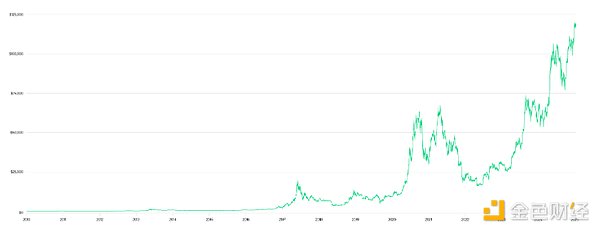If you step outside of conventional thinking, you will discover a better, faster, cheaper, and more globalized financial world beginning to emerge.
Written by: Matt Hougan, Chief Investment Officer of Bitwise
Translated by: AIMan@Golden Finance
Do you remember the nine-dot puzzle?
This is a classic visual puzzle often encountered at summer camps. The puzzle is as follows: how can you connect nine dots with four lines without lifting your pen?

This is a (literal) test of thinking outside the box. If you are confined to conventional thinking, you cannot connect all the dots.
However, it becomes easy when you draw outside its lines.

Since I read Bloomberg columnist Allison Schrager's recent column on cryptocurrency, I have been thinking about the nine-dot puzzle.
Schrager is an excellent writer, but she has long been skeptical of cryptocurrency. For years, she has predicted the demise of cryptocurrency in her columns, comparing it to tulips and other classic bubbles. Recently, she acknowledged that cryptocurrency will continue to exist, but now she has a new criticism: we don’t need it.
In her latest crypto column, "Does Your 401(k) Plan Have Bitcoin? I Won't Take That Risk," Schrager is dismissive of Bitcoin's future, pointing out that "government-issued currency is great."
She expressed similar views in previous columns: "The U.S. already has a means of payment—it’s called the dollar—and it works quite well."
These columns make me sad. "Quite great" and "quite well"?
Schrager is in a dilemma. She cannot think of a better way.
A Better Way
The reality is: our financial system is not that great.
Today, the average interest rate on checking accounts is 0.07%. The so-called "savings account" yields 0.38%. Checks can be cashed in five days. Stock settlements use T+1 (instead of weekend settlements, as we pointed out in our advertising last year). Visa takes only 1-3 business days to pay merchants while maintaining an 80% gross margin. Our government supports a few banks through implicit guarantees and regularly bails them out with taxpayer money. Meanwhile, the value of the dollar has fallen by about 80% during my lifetime.
Purchasing Power of the Dollar, 1900-2020

Source: Statista
"Quite great"?
One of the biggest reasons I work in crypto is that I know we can do better.
We can live in a world where payments are instant, fees are nearly zero, and the government does not erode your money through inflation.
We can live in a world where you can earn real returns from assets—returns that accumulate second by second, day by day, rather than being periodically accumulated based on the whims of service providers.
We can live in a 24/7, globalized world where you don’t have to pay currency exchange fees or interbank transfer fees while traveling.
I find it incredible that we so easily accept the status quo. Imagine if your email shut down at 4 PM on Friday and didn’t come back until 9:30 AM on Monday. Our brokerage accounts are essentially like that. Perhaps a bit happier, but that’s certainly not how to manage an economy.
When I meet advocates of TradFi, I want to show them how fast (almost instant) and cheap ($0.002) transfers are through Base. I want them to lend an asset on Aave and see interest accumulating every second. I want them to transfer funds between accounts at 7 PM on a Saturday because, hey, it’s your money. Of course, I also want to show them a Bitcoin chart that looks like the inverse of the dollar purchasing power chart I displayed above.
Bitcoin Price from 2009 to Present

Data Source: Bitwise Asset Management. Data range from July 17, 2010, to July 28, 2025.
I know what critics like Allison will say: where is the real-world use? If cryptocurrency is so great, why haven’t I used it to buy things?
The answer is that, like many new technologies, cryptocurrency is not yet perfect. It requires significant effort from technologists, investors, regulators, and legislators to fully realize its potential. Therefore, like most new technologies, initial adoption occurs at the margins, where existing systems are particularly poor.
But if you step outside of conventional thinking, you will discover a better / faster / cheaper / more globalized financial world beginning to emerge.
You can see this in companies like Yellowcard, which helps businesses in Sub-Saharan Africa use stablecoins for cross-border transactions, bypassing the inefficient banking system. You can see this in Stripe's $1 billion acquisition of Bridge, a stablecoin service provider that helps companies like Starlink invoice global customers. You can see this every weekend, as the stock market closes and macro traders turn to cryptocurrency. You can also see this in people like Ray Dalio, who reluctantly buys Bitcoin out of concern for the dollar's future.
New technologies are always like this. The first mobile phones were the size of suitcases and faced a lot of skepticism, but they were incredibly useful for a small number of politicians and CEOs. The first digital cameras had poor resolution and were "completely unusable," but they allowed NASA to send images from space and enabled journalists to write stories without dealing with film. Over time, technology has advanced. Today, we cannot imagine a world without digital cameras.
I expect the same for the cryptocurrency space. In the right circumstances, this technology has already proven capable of transferring funds and financial products better, faster, and cheaper than traditional systems. As regulatory frameworks evolve and user experiences improve, I believe we will see all financial products migrate to the cryptocurrency track.
This will provide a tremendous boost to the world. It also reminds us that we do not have to settle for the status quo. Things can get better.
I firmly believe that cryptographic technology can help us achieve this goal.
免责声明:本文章仅代表作者个人观点,不代表本平台的立场和观点。本文章仅供信息分享,不构成对任何人的任何投资建议。用户与作者之间的任何争议,与本平台无关。如网页中刊载的文章或图片涉及侵权,请提供相关的权利证明和身份证明发送邮件到support@aicoin.com,本平台相关工作人员将会进行核查。




